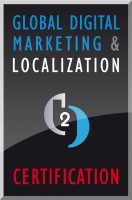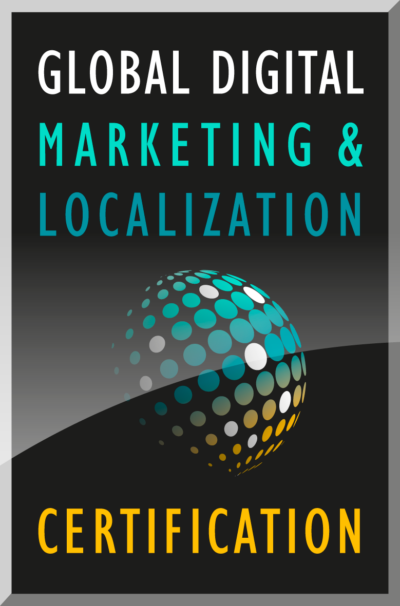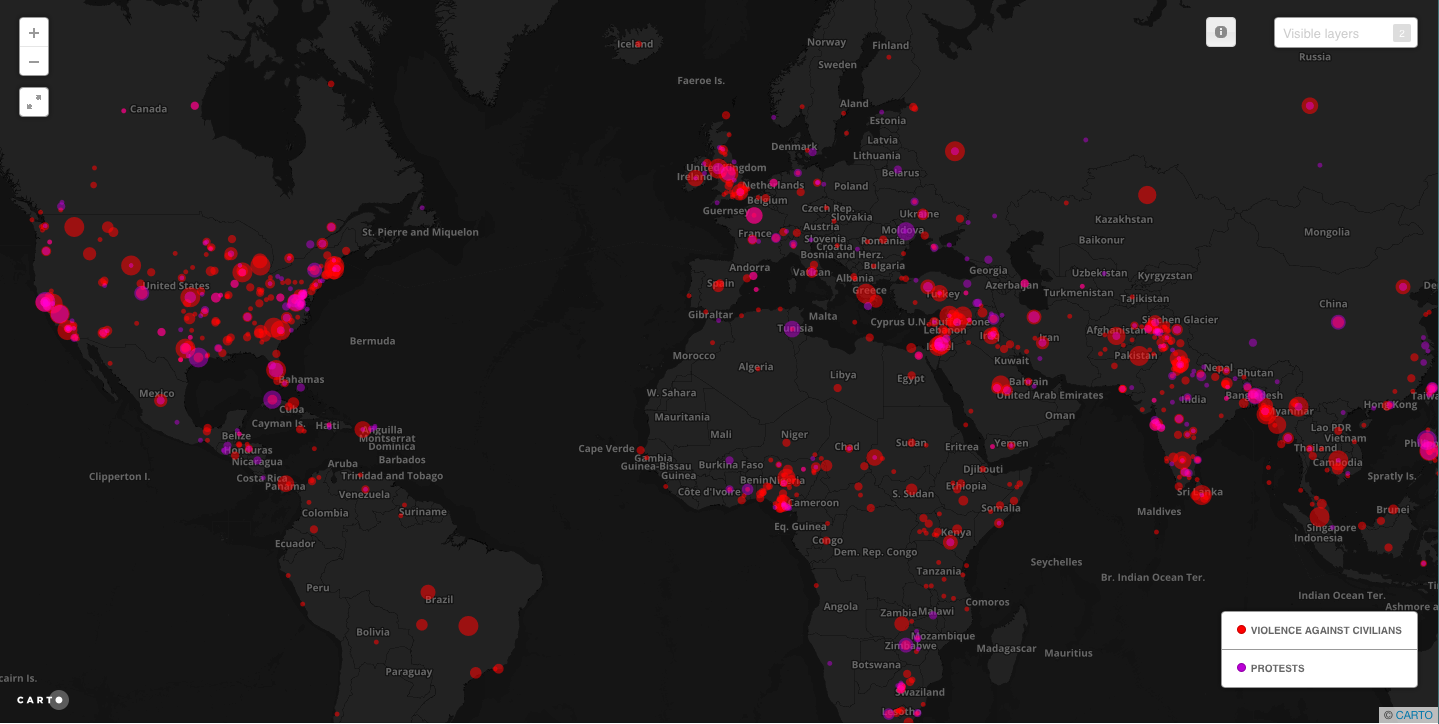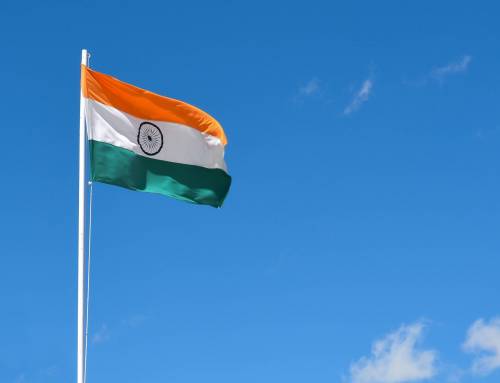This is a paper presented by Valeria Barbero, a recent graduate of the Global Digital Marketing and Localization Certification (GDMLC) program. This paper presents the work being produced by students of The Localization Institute’s Global Digital Marketing and Localization Certificate program. The contents of this Paper are presented to create discussion in the global marketing industry on this topic; the contents of this paper are not to be considered an adopted standard of any kind. This does not represent the official position of Brand2Global Conference, The Localization Institute, or the author’s organization.
Forever under the general rulings of the dreaded Murphy’s Law, every campaign, product launch or global market initiative has the potential to go wrong. The factors that could interfere are countless and while some are predictable and can be controlled, many others cannot. In general, factors that can be controlled pertain to the company and its organization and are called internal factors. Those that cannot be controlled constitute the external factors, or the environment. Politics is one of the main environmental factors and is in general out of companies’ control. When a company launches a product, a campaign or operations in a foreign market, it can be faced with problems if the launch runs into issues that are political in origin.
The ways in which politics affects business and marketing operations are typically two. I shall call them the ‘structural way’ and the ‘populist way’. Structural influences are determined by elements that are already in place and are more or less predictable like active legislation, taxation, trade regulations, international treaties and agreements, the ruling party or government in place until the end of the mandate, etc. Populist factors pertain to public identities and sensitivities that are linked to people’s political identity and it can be related to ideology, history, nationalism, even mythology; any element that is constitutive of people’s political identity has the potential to backlash if people feel it is being challenged or disrespected or if it undermines their belief system. Populist factors are far more volatile in nature and are notoriously difficult to predict. However, in the digital age we live in, they have the potential to be even more disruptive than the structural ones as reactions can be shared and spread online in a matter of minutes and regaining control can be very costly and challenging. I will discuss ways to deal with structural factors first and then I will discuss issues that relate to populist political reactions.
Structural Political Constraints
In the late 1960s Professor Aguillar of the Harvard Business School developed a model to analyze or scan the environment and try to forecast multiple scenarios that could help the decision makers during the early phases of the business strategy. The model, originally by the name of ETPS (Economics, Technological, Political and Social environments), later evolved into PESTEL or PESTLE, with the addition of the Legal and Environmental factors as they progressively became more important from a business standpoint. These factors are tremendously important and they represent huge constraints on businesses both domestically and internationally. At the global level, all the factors get multiplied by every country that is part of the business strategy and added to the international treaties, conventions, customs and practices. The enterprise can be daunting and a detailed analysis of the environment is an absolute must. Obviously some factors are more stable and more predictable than others, however the potential for change is always there and a continuous scanning of the political landscape can make a big difference when planning a campaign or an international business expansion.
We have several recent examples of rapid and unexpected changes in the political environment that brought considerable uncertainty to global business operations. Both the Brexit referendum in the UK and Trump’s unexpected election in the US have significantly increased the risk factors for certain industries and their international operations. Even for companies that were not directly affected by these changes, the increase in the uncertainty and risk factors is bound to impact every international business as it affects the overall economic environment and most of all the financial one, and that is how ultimately businesses are impacted.
Some of the questions that the PESTEL analysis will help you answer are:
- Is the instability in East Asia caused by North Korea’s erratic policies going to affect the mobile phones market? If I am trying to launch a campaign for Samsung’s phones accessories, should I wait to launch when political stability is restored? If I want to open a subsidiary office in Asia, should I consider Singapore instead of Seoul or Tokyo?
- I have had offices in London for two decades and have both my international marketing and EMEA operations based there. What should I do after Brexit goes into effect? Should I relocate my offices to Ireland or to Amsterdam? Which location offers advantages in terms of logistics, taxation incentives, labor laws, etc.
- How is the current stance Elon Musk took towards the Trump administration going to affect my marketing campaign for solar panels and electrical storage batteries I was about to undertake? Will the Trump administration try to boost the image of traditional fossil fuel industry? Will they offer incentives to fossil fuel industries that could potentially harm my products’ popularity and sales?
- I am a language service provider with offices in Barcelona. What is the likelihood of Catalunya gaining independence from Spain? If it happens at all, what are the chances of this being a peaceful, smooth transition? Will an independent Catalunya be business friendly or are they likely to increase taxation? Would I be better off relocating to Prague, Paris, Madrid or Milan?
Through the use of predictive scenarios companies will not have certainties but they will reduce the risk factors considerably and they will have time to develop alternative strategies if the outcome they were hoping for becomes more or less likely.
Aside from the PESTEL tools for analysis that can be easily found online, research can be purchased or scenario building tools can be used to guide strategy. An updated and complete source of information about all countries that can be invaluable is the CIA Country World Factbook. While it is obviously linked to the government, it is very focused on facts and presents a staggering amount of data.
https://www.cia.gov/library/publications/the-world-factbook/docs/profileguide.html
There are countless books and articles written about PEST/PESYEL analysis and they are easy to find. For a good, synthetic overview used here please visit:
- Oxford College of Marketing (2017). What is a PESTEL analysis?. Retrieved from http://blog.oxfordcollegeofmarketing.com/2016/06/30/pestel-analysis/
- Wikipedia (2017). PEST Analysis. Retrieved from https://en.wikipedia.org/wiki/PEST_analysis
Populist Political Constraints
While structural political factors such as elections, referenda, treaty renewals, etc. are very big factors in the business environment, there are other ways in which political issues can impact companies’ marketing operations, and those are the reactions of the people that are linked to their political identities. These factors are even more difficult to analyze and more unpredictable than the structural political factors, and in today’s digital world where things go viral in a matter of minutes, they have acquired a very important status.
Examples of these are Google’s repeated gaffes over the labeling in Google Maps of territories that are disputed. It has angered or caused protest, boycotts, petitions and open condemnation from Israel, the Palestinians, China, India, Iran, Nicaragua,Turkey and even the forgotten Sahrawis, just to name a few.
The dispute over territory is particularly sensitive as territories are not just demarcations lines on a map, there is an entire social and psychological dimension that links people to territories. This has deep implications on people’s identities and their ties to social and political groups. Feelings of belonging to a territory, of the motherland, the homeland, of entitlement to a specific territory have fueled countless conflicts throughout history and are a major motivation for social and political action. So when we label a geographic region “Palestine”, “Occupied Territories”, “Palestinian Authority”, “Gaza and West Bank” it might be just a name to us but it will touch the identity of the people on either side of the disputed land, bringing back feelings of conflict, despair, oppression, unrecognized self-determination, and ultimately just anger and protest against the insensitivity of the company that produced the map. Considering that Google Maps are used as reference by the wide majority of websites who want to indicate their location to the user, it is easy to see how Google has a major responsibility to ensure that naming and labeling on the maps are fair and respectful to the people involved. Moreover, disputed territories often acquire an ideological dimension and other groups, states and political parties will choose sides and might act in defense of or solidarity with the offended party. For example, when Europeans participate in the boycott of products in solidarity with the Palestinians or a worldwide backlash against products that have even the slightest association with anti-semitic groups.
While often the reaction comes from people, other times it comes directly from the government. Google has had several incidents with the Indian government as well as with the Chinese and the Iranian ones. With India the clash was both over the attribution of Jammu and Kashmir to Pakistan in 2005 and then again in 2010 over Arunachal Pradesh, a disputed territory between India and China next to Bhutan. Google had to modify the map after the official complaint of the Indian government, however, not to offend the Chinese, Google had to initially produce 3 different maps and has since changed to 2 versions of the map. Now, to the Indian user Arunachal Pradesh appears as part of India and to the rest of the world the territory is surrounded by a dotted line that indicates the disputed status. The same goes for Jammu and Kashmir, since India’s official policy is to deny its disputed status, Google Maps India shows the region as part of the Indian territory. See my comparison from Google maps below. Now, while the dispute over Jammu and Kashmir is quite complex and extremely sensitive both for India and for Pakistan, Arunachal Pradesh is an area close to Tibet that is a very tiny fraction of territory when compared to the size of India and China, and while it might have had some strategic military value in the age of traditional warfare, in the age of long distance ballistic missiles and extensive air to ground warfare technology it is puzzling that the two countries still cling to that sliver of territory and feel offended if their perceived rights are not acknowledged. This clearly shows how the link between people, identity and territory goes beyond the realm of what we would consider a rational calculation of interest and into the realm of the feelings of group identity and belonging that can react to perceived insensitivity and escalate the reaction to a completely different level.
Comparison created by the author by taking screenshots of the Indian Google Maps site and the US one.
On the occasional protests against Google Maps’ labels for disputed territories and on Google’s efforts to manage them see:
- Bogen, M. (2016). How Google has managed the tricky balancing act of geopolitics, Retrieved from http://www.newsweek.com/googles-place-geopolitics-493769
- Leigh, A. (2016). Palestine Row: why neutrality in tech is an impossible dream, The guardian. Retrieved from https://www.theguardian.com/technology/2016/aug/11/google-maps-palestine-neutrality-tech
- Dempsey, C. (2012). The Politics of Google’s Mapping.GIS Lounge. Retrieved from https://www.gislounge.com/the-politics-of-googles-mapping/
- UCLA Asia Pacific Center (2005). India protests Google Kashmir map. Retrieved from http://www.international.ucla.edu/apc/article/34660
So, how do we navigate the tricky waters of territorial disputes and political sensitivities when we want to launch our products, campaigns or when we plan to expand globally?
The answer is research, research and research or……purchase research! If you can’t purchase geopolitical analysis, here are some resources that are reliable and updated.
This updated map from the GDELT Project, by the United States Institute of Peace is a fantastic resource as it shows both conflicts and protests. It is continuously updated and contains links to other resources, like articles and documents that describe the ongoing actions and issues more in depth.
The live map can be found here:
https://www.gdeltproject.org/globaldashboard/
There are many other interactive maps that track the conflicts around the world and it is always a good idea to consult more than one as the concept of war itself is disputed and what is considered an act of oppression by some, is considered a perfectly legal and justified action by others. So, getting information from multiple sources and determining whether the situation has the potential to be problematic for a product or a campaign launch or for market expansion plans, is very important. This is not an exhaustive list of where to find maps of conflicts, but a list of few, reputable sources:
The Global Conflict Tracker by the Council on Foreign Relations
https://www.cfr.org/interactives/global-conflict-tracker#!/global-conflict-tracker
IRIN – A non-profit organization that tracks forgotten conflicts
http://www.irinnews.org/maps-and-graphics/2017/04/04/updated-mapped-world-war
Wikimedia – Non-profit file repository devoted to the diffusion of public domain and freely-licensed educational media content
https://commons.wikimedia.org/wiki/Category:Maps_of_the_world_showing_all_ongoing_conflicts
United Nations – The UN has a map where they show all the ongoing peacekeeping operations:
http://www.un.org/en/peacekeeping/operations/current.shtml
For a more academic take, Exploring Geopolitics is an interesting resource as it is broader in scope. It is not just limited to conflicts but it presents information on territorial and geopolitical issues as well as the sociopolitical and psychological dimension of geopolitics, so it is worth a look:
http://www.exploringgeopolitics.org
Populist backlashes to an insensitive campaign can also happen when there was no direct territorial or political implication, but the reference is to a cultural element that has come to embody a territorial conflict. For example, when Orange Telecom, a former telecom provider in the UK, wanted to open retail points in Northern Ireland, they were faced with huge problems because of the sensitivities that their name and slogan, “The future’s bright, the future’s Orange”, might evoke in a land where the two sides of the conflict have long associated each other with the colors orange and green. Orange for the Protestants and particularly the members of the Orange Order, and the green for the Catholics and Unionists. This was 1996 and obviously, the company was worried about the commercial backlash from the Catholic population, but also about possibly sparking violence in a situation where sectarian violence was sporadic but still very much a reality in the daily political life.
In relation to the issues faced by Orange in Ulster/Northern Ireland see:
- Wikipedia (2017). Orange (UK). Retrieved from https://en.wikipedia.org/wiki/Orange_(UK)
- Tooher, P. (1996). The future’s not so bright as Orange gets the red light in Ulster. Retrieved from http://www.independent.co.uk/news/the-futures-not-so-bright-as-orange-gets-the-red-light-in-ulster-1328424.html
- Merriman, C. (2015). The fall and demise of the Orange brand. The Inquirer. Retrieved from https://www.theinquirer.net/inquirer/feature/2397323/the-fall-and-demise-of-the-orange-brand
Conclusion
Every launch or international expansion carries a certain amount of risk that, while it cannot be completely avoided, it can certainly be mitigated by extensive research, curiosity for the world we live in and an appreciation for general knowledge that leads us to read and engage with the rest of the world. While retrieving information is easier than it has ever been, discerning authoritative material from misleading information can be tricky, so using and researching multiple sources both online and in paper format is essential. With regards to information on political issues this is even more important since political issues can very easily become partisan issues and view the facts though the powerful lenses of political ideology. Although not an easy task, understanding the political environment through the PESTEL analysis and building strategic scenarios based on political realities in the markets a company is targeting, is a fundamental step in creating a solid international business strategy.
Author Bio:

 If you are interested in learning more about the Global Digital Marketing and Localization Certification please click here. The program offers dual credentials, with a Certificate from the University of North Carolina Wilmington and a Certification from The Localization Institute. Valeria’s feedback on the course:
If you are interested in learning more about the Global Digital Marketing and Localization Certification please click here. The program offers dual credentials, with a Certificate from the University of North Carolina Wilmington and a Certification from The Localization Institute. Valeria’s feedback on the course:[t]his course really opened up a broader perspective on all the different facets of localization. Often in our industry we tend to focus only on one aspect, while the adaptation of a product to a market really spans from linguistic, cultural, regulatory, legal, economic, demographic, to social and political aspects. This course is great for getting an overview of all the dimensions that will have to be taken into account for the global release of a product.
In addition to the course material for the Global Digital Marketing and Localization Certificate and the resources indicated in the paper:
Singh, N., Pereira, A. (2005). The Culturally Customized Web Site – Customizing Web Sites for the Global Marketplace. Oxford, UK: Elsevier.
Singh N. (2012), Localization Strategies for Global E-Businesses. New York: Cambridge University Press.
Schlegel A. (2016), Truly Global – The Theory and Practice of Bringing Your Company to International Markets, Victoria BC, Canada: Friesen Press.
White, M.(2009), A Short Course in International Marketing Blunders – Mistakes Made by Companies that Should Have Known Better, Brno, Tribun EU, 3rd Ed. Retrieved from: https://books.google.com/books?id=X8UHhkIRUvIC&pg=PR2&lpg=PR2&dq=international+marketing+blunders&source=bl&ots=1KcbReS-sf&sig=Cotu9fnsPya7W0Zoktqs4wl9ytI&hl=en&sa=X&ved=0ahUKEwjKu9710aPWAhUI2WMKHSHlCA84ChDoAQhDMAY#v=onepage&q=international%20marketing%20blunders&f=false
Kaynak, E. (1996), International Marketing: Sociopolitical and Behavioral Aspects. Binghamton, NY: Haworth Press. In particular the Introduction and Chapters 6 and 9.
Strandsbjerg J. (2010). Territory, Globalization and International Relations – The Cartographic Reality of Space, Palgrave Macmillan. In particular the chapter “The significance of territory”, pp. 24-26.
Delaney, D. (2005). Territory: A Short Introduction, Malden, MA: Blackwell Publishers. In particular pp. 10-16.
Klinke, I. (2009). Geopolitics: critical vs. classical. Exploring Geopolitics. Retrieved from
Disclaimer











